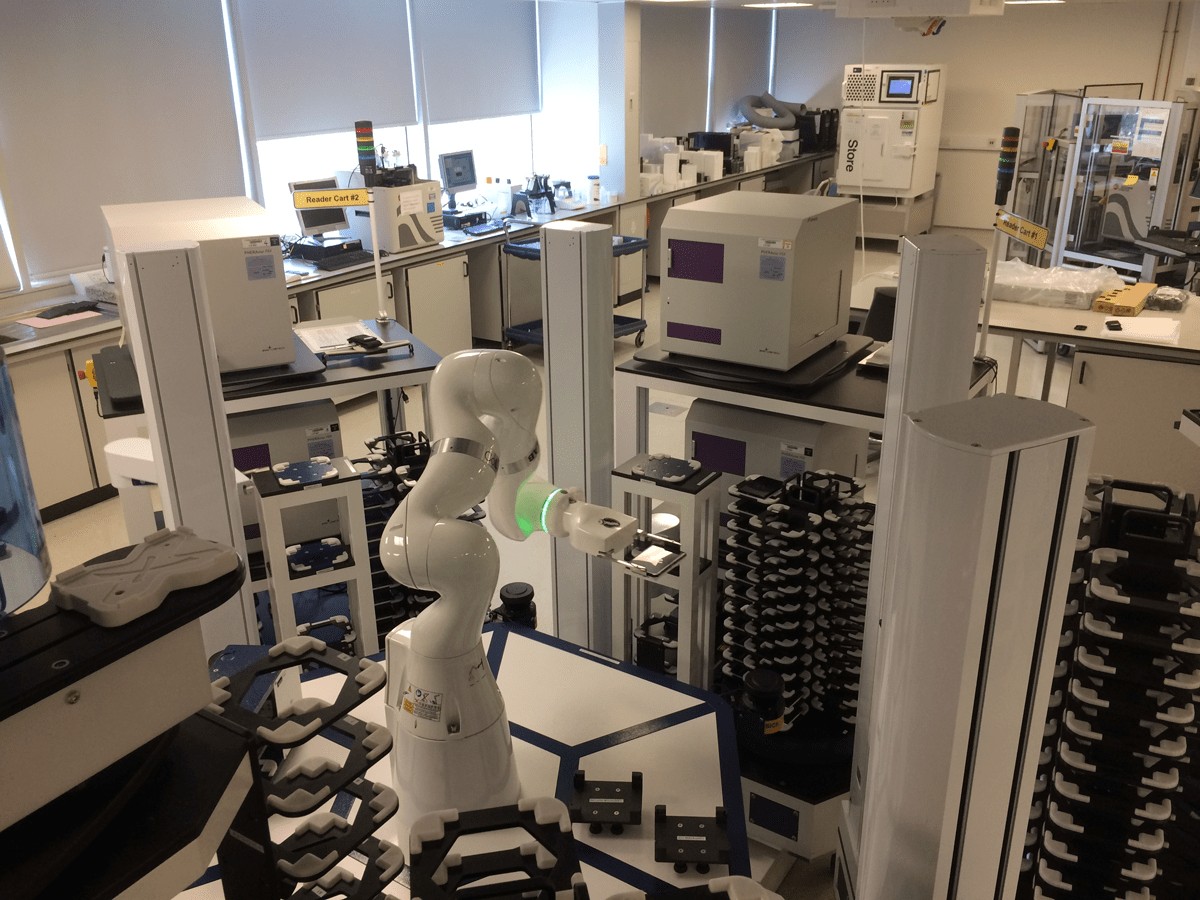High-throughput screening (HTS) has revolutionised the field of biotechnology and life sciences by enabling the rapid testing of numerous compounds for specific biological targets. This technology has become crucial in modern peptide discovery, facilitating the identification of novel peptides with therapeutic potential. Companies such as Pure Peptides UK are at the forefront of utilising HTS for peptide research, accelerating the discovery process and reducing the time and cost associated with bringing new treatments to market.
By leveraging HTS, researchers can screen vast compound libraries, identifying potential drug candidates with increased efficiency. This approach has transformed the way researchers identify and develop new peptides, paving the way for innovative treatments.
Key Takeaways
- HTS has revolutionised the field of biotechnology and life sciences.
- Pure Peptides UK is a notable company utilising HTS for peptide research.
- HTS enables the rapid screening of vast compound libraries.
- This technology facilitates the identification of novel peptides with therapeutic potential.
- HTS accelerates the discovery process, reducing time and cost.
Introduction: Accelerating the Pace of Life Sciences Research
In the rapidly evolving landscape of life sciences, high-throughput screening (HTS) stands out as a critical methodology that is transforming the way researchers approach peptide-based studies. This technique has become indispensable in both academic and industrial settings for screening various libraries, including combinatorial chemistry, genomics, protein, and peptide libraries.
What is High-Throughput Screening (HTS)?
High-throughput screening is a method that allows for the rapid testing of large numbers of compounds against specific biological targets. This is achieved through the use of automated systems that can handle and process thousands of samples in a relatively short period. HTS has revolutionised the field by significantly reducing the time and resources required to identify potential drug candidates or peptides with desired properties.
The process involves several key steps, including the preparation of compound libraries, the development of robust assays to test these compounds, and the use of sophisticated data analysis tools to identify hits. The application of HTS is not limited to any particular area of life sciences; it is widely used in research related to drug discovery, including studies focused on longevity and ageing.
How HTS is Transforming Peptide-Based Research
Peptide-based research has benefited greatly from the advent of HTS. The ability to quickly screen large peptide libraries against specific targets has opened up new avenues for the discovery of novel peptides with therapeutic potential. The use of HTS in peptide research is accelerating the identification of peptides that could have significant implications for various therapeutic areas, including treatments aimed at promoting healthy ageing and longevity.
| Application of HTS | Impact on Peptide Research |
|---|---|
| Rapid Screening of Peptide Libraries | Accelerates the discovery of novel peptides with therapeutic potential |
| Identification of Peptides for Specific Targets | Enhances the understanding of peptide-target interactions |
| Optimisation of Peptide Properties | Facilitates the development of peptides with improved stability and efficacy |
The integration of HTS into peptide-based research is not only enhancing our understanding of peptide biology but is also paving the way for the development of new therapeutic strategies. As the field continues to evolve, the role of HTS is likely to become even more pivotal in driving innovation and discovery.
The Core Technologies of a Peptide HTS Workflow
At the heart of modern peptide discovery lies the High-Throughput Screening (HTS) workflow, a sophisticated process that integrates various advanced technologies. The effectiveness of HTS in identifying target-specific compounds is largely attributed to its precise focus on single mechanisms, leveraging techniques such as fluorescence resonance energy transfer (FRET) and homogeneous time-resolved fluorescence (HTRF) for compound identification.
Peptide Library Generation and Synthesis Platforms
Peptide library generation is a critical component of the HTS workflow, enabling the creation of diverse peptide collections for screening. Advanced synthesis platforms facilitate the rapid production of high-quality peptides, thereby accelerating the discovery process. These platforms often incorporate automated synthesis technologies to enhance efficiency and reduce production times.
Automated Robotics and Liquid Handling Systems
Automated robotics and liquid handling systems play a vital role in HTS workflows, allowing for the precise and rapid handling of samples and reagents. These systems minimize human error and maximize throughput, enabling researchers to screen large peptide libraries efficiently. The integration of robotic automation has significantly enhanced the scalability of HTS processes.
Assay Development and Sensitive Data Readouts
The development of robust assays is crucial for the success of HTS campaigns, as they provide the means to detect and quantify peptide interactions. Techniques such as FRET and HTRF offer sensitive data readouts, enabling researchers to identify promising peptides with high accuracy. The use of sensitive detection methods is essential for uncovering novel peptides with potential applications in biotechnology and longevity research.
Bioinformatics for Data Analysis and Hit Identification
Bioinformatics tools are indispensable for analyzing the vast amounts of data generated by HTS workflows. These tools facilitate the identification of hits and the prioritization of peptides for further investigation. By leveraging advanced bioinformatics, researchers can uncover insights into peptide function and potential applications, driving innovation in fields such as biotechnology and contributing to advancements in longevity.
Key Applications of HTS in Scientific Research
HTS has emerged as a crucial tool in modern biotechnology, facilitating groundbreaking research. Its applications span various areas of life sciences, driving innovation and discovery.
Identifying Ligands for Receptor Binding Studies
One of the primary applications of HTS is in identifying ligands for receptor binding studies. By screening large peptide libraries, researchers can discover novel ligands that bind to specific receptors, shedding light on complex biological processes. Pure Peptides is at the forefront of this research, utilising HTS to identify ligands that can be used in various therapeutic applications.
Screening for Enzyme Inhibitors or Activators
HTS is also extensively used for screening enzyme inhibitors or activators. This involves testing thousands of compounds to identify those that modulate enzyme activity, which is crucial for understanding disease mechanisms and developing new treatments. The use of HTS in this area has the potential to revolutionise the field of life sciences by enabling the rapid identification of potential therapeutic agents.
Materials Science: Discovering Peptides with Novel Properties
In addition to its applications in biological research, HTS is being used in materials science to discover peptides with novel properties. This includes identifying peptides that can be used in the development of new materials, such as self-healing materials or peptides with specific optical properties. Pure Peptides is involved in this cutting-edge research, pushing the boundaries of what is possible in materials science.
The versatility of HTS in scientific research underscores its value as a tool for driving innovation in biotechnology and life sciences. By enabling the rapid screening of large compound libraries, HTS is accelerating the discovery process and opening up new avenues for research and development.
Challenges and Future Directions in Automated Screening
As HTS continues to evolve, it faces numerous challenges, including the need to overcome false positives and negatives in large datasets. The process of identifying potential hits from vast libraries of compounds is complex and requires sophisticated strategies to ensure accuracy and reliability.
Overcoming False Positives and Negatives in Large Datasets
One of the significant challenges in HTS is managing false positives and negatives. False positives can lead to unnecessary follow-up studies, wasting resources, while false negatives can result in missing potentially valuable compounds. To address this, researchers are developing more sophisticated data analysis techniques and implementing rigorous validation protocols.
- Improving assay robustness to reduce variability
- Implementing advanced statistical methods for hit identification
- Utilising orthogonal validation techniques to confirm hits
Integrating AI and Machine Learning for Predictive Screening
The integration of Artificial Intelligence (AI) and Machine Learning (ML) is revolutionising HTS by enhancing predictive capabilities and streamlining the screening process. AI and ML algorithms can analyse vast datasets to identify patterns and predict the behaviour of compounds, thereby improving the efficiency of hit identification.
- AI-driven predictive modelling for compound activity
- ML algorithms for optimising screening conditions
- Integration of multi-omics data for comprehensive analysis
The Future of Miniaturization and Lab-on-a-Chip Technology
The future of HTS lies in further miniaturization and the development of lab-on-a-chip technology. These advancements promise to increase the efficiency and cost-effectiveness of screening processes, enabling researchers to conduct more experiments with less material.
| Technology | Advantages | Applications |
|---|---|---|
| Lab-on-a-Chip | Reduced reagent consumption, increased throughput | Drug discovery, diagnostics |
| Microfluidics | Precise control over fluid dynamics, miniaturization | HTS, chemical synthesis |
In conclusion, as HTS continues to advance, addressing the challenges associated with large-scale screening will be crucial. The integration of AI and ML, along with advancements in miniaturization, will play a significant role in shaping the future of biotechnology research, particularly in areas related to longevity and disease treatment.
Conclusion: HTS as a Catalyst for Innovation in Biotechnology
High-Throughput Screening (HTS) is revolutionizing the field of biotechnology by enabling the rapid and efficient screening of large numbers of compounds. This technology is significantly accelerating the identification of potential drug candidates and optimal process conditions, thereby driving innovation in life sciences research.
Pure Peptides UK is leveraging HTS to drive advancements in peptide research, contributing to the development of novel peptides with significant therapeutic potential. The integration of HTS in life sciences research is expected to lead to breakthroughs in longevity research, enabling the discovery of new treatments and therapies.
By facilitating the estimation of the potential for toxicity and understanding the mechanisms of action of a large number of chemicals, HTS is poised to make a substantial impact on the future of biotechnology. As this technology continues to evolve, its influence on longevity and life sciences research is likely to grow, leading to new and innovative applications.
FAQ
What is high-throughput screening (HTS) and how is it used in peptide discovery?
High-throughput screening is a technology used to rapidly screen large numbers of compounds against specific biological targets. In peptide discovery, HTS enables the identification of novel peptides with therapeutic potential, accelerating the discovery process and reducing the time and cost associated with bringing new treatments to market.
How is HTS transforming peptide-based research in life sciences?
HTS is transforming peptide-based research by enabling the rapid evaluation of large numbers of compounds against specific biological targets. This capability is particularly valuable in peptide-based research, where the identification of peptides with desired properties is crucial.
What are the core technologies involved in a peptide HTS workflow?
The core technologies involved in a peptide HTS workflow include peptide library generation, automated robotics, assay development, and bioinformatics. These technologies contribute to advancements in biotechnology and longevity research by enabling the efficient identification of peptides with desired properties.
How is Pure Peptides UK utilising HTS in peptide research?
Pure Peptides UK is leveraging HTS to advance peptide research, contributing to advancements in life sciences and longevity. They are applying HTS in various research areas, including the identification of ligands for receptor binding studies and the discovery of peptides with novel properties.
What are some of the challenges faced by HTS, and how are they being addressed?
Some of the challenges faced by HTS include overcoming false positives and negatives in large datasets. These challenges are being addressed through the integration of AI and machine learning, which is expected to enhance the predictive capabilities of HTS.
What is the future of HTS in biotechnology and longevity research?
The future of HTS in biotechnology and longevity research is expected to be shaped by advancements in miniaturization and lab-on-a-chip technology, as well as the integration of AI and machine learning. These developments will further increase the efficiency and cost-effectiveness of the screening process, driving innovation in peptide research.
How is HTS contributing to advancements in longevity research?
HTS is contributing to advancements in longevity research by enabling the identification of novel peptides with therapeutic potential. By accelerating the discovery process, HTS is facilitating the development of new treatments that could have significant implications for longevity.

